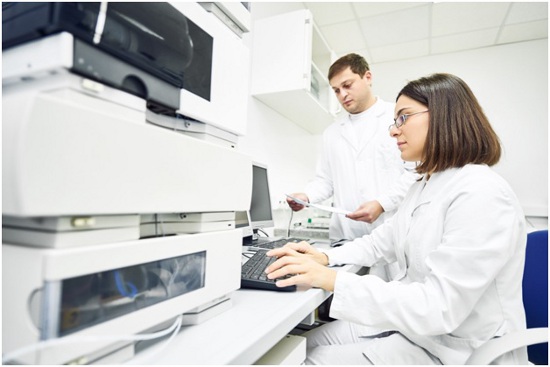Do you have a business venture that involves screening samples? If so, then you might want to consider using a chromatography machine.
Doing so can provide you with valuable insights into the composition of liquids and solid materials. You might use it to investigate mildew in tea leaves. Also, you might use it to identify soil properties.


Once you understand how it works, it will be easy for your team to achieve the results that you set out to achieve. Using a chromatography machine involves steps that you need to follow.
To learn more about using a chromatography machine, here’s a short beginner’s guide to using one.
Understanding Chromatography
Chromatography is a technique used to separate complex mixtures of compounds. It works by running a sample through a fixed bed of stationary phase, often silica or alumina. This fixed bed contains particles or layers of stationary phase that act as a filter.
Also, as the sample moves through it, each molecule travels at a different rate according to its interactions with the stationary phase. This separation is always based on differences between molecules, whether it is size, shape, or chemical properties.
Types of Chromatography Machines
Chromatography machines are used to separate and determine the components of a solution or mixture. There are types of these machines including the following:
Liquid Chromatography (LC)
This machine utilizes a solvent to separate and analyze components of a mixture. It is a powerful analytical technique used in biochemistry, pharmacology, and environmental sciences.
LC works by dissolving the contents of the sample in a solution that has been run through an LC column. An electric current is then used to drive the solvent with the ingredients of the solution through a series of particles in the column. These particles are of different sizes and shaped to separate, and disperse, the different components of the sample.
Gas Chromatography (GC)
GC works through a column filled with a special stationary phase under pressure. As a gas mixture passes, different components of the mixture interact with the stationary phase and separate.
The components that are separated are detected by a detector which gives a unique signature of the compounds. This signature can identify the separate compounds in the original mixture.
GC is especially effective for separating volatile and low molecular weight compounds. It also has a high resolution making it ideal for trace detection.
High-Performance Liquid Chromatography (HPLC)
HPLC separates complex and active components, as well as identifies and quantifies them. It is a method with a broad range of applications.
It includes environmental, pharmaceutical, biological, chemical, medical, and industrial research. Also, it separates, identifies, and quantifies components with the help of a stationary phase and a mobile phase.
A pump forces a sample mixture, or eluent, through a column. As the mixture passes through the column, different molecules elute at different rates due to their unique properties.
Thin-Layer Chromatography (TLC)
This machine separates and analyzes components from complex mixtures. It is most commonly used in pharmaceutical, forensic, and environmental testing.
TLC works by running a mobile phase, such as a solvent, through a stationary phase, usually silica gel adsorbent. This process then turns the molecules in the mixture into more components.
The stationary phase will absorb one type of component, while the mobile phase will pass the other. By looking at the levels and movement of the components, a scientist can determine what components make up the mixture.
Components of a Chromatography Machine
A chromatography machine is a complex device used to separate and identify substances in a mixture. It consists of several distinct components including the following:
Mobile Phase Reservoir
The mobile phase, which could be a liquid or gas, is always stored here. It’s responsible for carrying the sample through the chromatography system.
Pump
In liquid chromatography, the pump generates the necessary pressure to move the mobile phase through the system. This pressure ensures a controlled flow rate, crucial for accurate separations.
Column
The column is the heart of the chromatography machine. It contains the stationary phase, which interacts with the sample components, causing them to separate as they travel through the column.
Detector
As separated compounds exit the column, they pass through the detector. The detector records the presence and quantity of these compounds, generating valuable data.
Data Output and Analysis
The data collected by the detector is presented in a chromatogram, which is a graphical representation of the separation. Scientists analyze this data to identify and quantify the components within the sample.
Operating a Chromatography Machine: Step by Step
Now that we’re familiar with the components, let’s walk through the process. Operating a chromatography machine requires the following multiple steps:
Sample Preparation
Before using the chromatography machine, your sample needs proper preparation. This may involve extracting, purifying, and concentrating the target compounds. The sample is then placed in chromatography vials and sealed with vial caps to prevent contamination.
Setting up the Mobile Phase
Choose the appropriate mobile phase based on the nature of your sample and the type of chromatography you’re performing. Pour the mobile phase into its reservoir and ensure it’s free from air bubbles.
Column Selection
Select a column with the appropriate stationary phase for your separation needs. Column selection is crucial, as different phases interact differently with sample components.
Calibration and System Suitability
Before running your sample, it’s essential to calibrate the detector. Also, ensure that the system is suitable for accurate analysis.
Running the Sample
Inject the prepared sample into the injector system. The pump will start pushing the mobile phase through the column, and the separation process begins.
Data Collection
As compounds exit the column, they are all detected, and the detector generates data. This data is presented as peaks on a chromatogram.
Analysis
Examine the chromatogram to identify and quantify the separated compounds. Compare retention times of peaks with known standards for accurate identification.
Interpretation
Interpret the data to conclude the composition of your sample. Advanced software can assist in complex data interpretation.
Learn More About Chromatography Machine
Overall, using a chromatography machine can be a complex process. Therefore, it is important to have a basic understanding of the components and the steps necessary to operate one. Take your time, and be sure to consult an expert if you have any further questions.
For more on chromatography and other scientific and medical technology, be sure to check out our other blog posts.

























